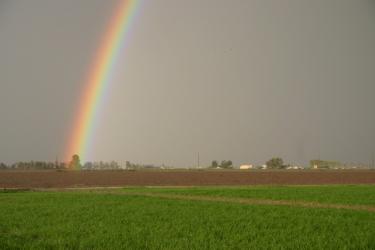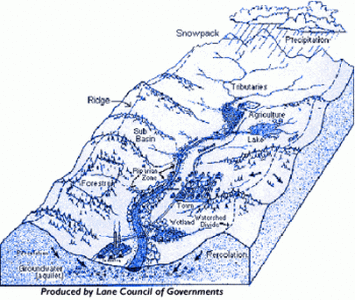Integrated Resource Management

What is IRM?
Integrated resource management (IRM), by definition, is “a planning and decision making process that coordinates resource use so that the long-term sustainable benefits are optimized and conflicts among users are minimized. IRM brings together all resource groups rather than each working in isolation to balance the economic, environmental and social requirements of society.”[As stated in the California Natural Resources Agency December, 2010 white paper and action plan, The Future of Natural Resource Management.]
IRM was introduced by the USDA Natural Resources Conservation Service over 20 years ago and recently came to the policy forefront through the California Department of Conservation Watershed Program and the CA Department of Fish and Game Strategic Vision. IRM proponents statewide are now working to re-balance local, state and federal resource management activity to avoid fragmented and ultimately inefficient functioning.
IRM emphasizes community-based strategies, with capacity and flexibility to address multiple and diverse resource concerns. As California’s funding resources are expected to continue shrinking, IRM provides a solution for achieving necessary protection of our valuable natural resources. The approach just described is known as Integrated Resource Management (IRM), and defined as:
Integrated resource management (IRM), by definition, is “a planning and decision making process that coordinates resource use so that the long-term sustainable benefits are optimized and conflicts among users are minimized. IRM brings together all resource groups rather than each working in isolation to balance the economic, environmental and social requirements of society.”[As stated in the California Natural Resources Agency December, 2010 white paper and action plan, The Future of Natural Resource Management.]
IRM was introduced by the USDA Natural Resources Conservation Service over 20 years ago and recently came to the policy forefront through the California Department of Conservation Watershed Program and the CA Department of Fish and Game Strategic Vision. IRM proponents statewide are now working to re-balance local, state and federal resource management activity to avoid fragmented and ultimately inefficient functioning.
IRM emphasizes community-based strategies, with capacity and flexibility to address multiple and diverse resource concerns. As California’s funding resources are expected to continue shrinking, IRM provides a solution for achieving necessary protection of our valuable natural resources. The approach just described is known as Integrated Resource Management (IRM), and defined as:
What is Watershed-based Integrated Resource Management?
A watershed is the land area extending from the topographic high points where water collects, such as ridges, down to the topographic low point where the area drains into a creek, river, bay, ocean or other waterbody.
Watershed-based integrated resource management is the integration and coordination of activities that affect the watershed's natural resources and water quality. The premise of this concept is that many water quality and ecosystem problems are best prioritized, addressed, and solved at the watershed level rather than at the individual waterbody level.
Major features of a watershed-based integrated resource management approach are:
Watershed-based integrated resource management is the integration and coordination of activities that affect the watershed's natural resources and water quality. The premise of this concept is that many water quality and ecosystem problems are best prioritized, addressed, and solved at the watershed level rather than at the individual waterbody level.
Major features of a watershed-based integrated resource management approach are:
- Targeting priority problems based on physical, chemical and biological boundaries rather than city/county/state boundaries, and accounting for the human patterns within those boundaries
- Promoting a high level of stakeholder involvement
- Developing integrated solutions that make use of the expertise and authority of multiple agencies and organizations
- Measuring success through monitoring and other data gathering
- Balancing the economic, environmental and social requirements of society
- Utilizing horizon-level assessments (broad and forward-thinking) of current and anticipated needs that yield multiple benefits and sustainable solutions
The Watershed Planning Process
Since the late 1980s, organizations and agencies have moved toward managing water quality by using a watershed approach, which includes stakeholder involvement and management actions supported by sound science and appropriate technology. The watershed planning process works within this framework to identify and quantify specific causes and sources of water quality problems. It also identifies water quality goals and specific actions required to solve water resource challenges.
A watershed plan is a strategy and a work plan for achieving water resource goals that provides assessment and management information for a geographically defined watershed. It includes the analyses, actions, participants, and resources related to development and implementation of the plan. The watershed planning process uses a series of cooperative, iterative steps to characterize existing conditions, identify and prioritize problems, define management objectives, and develop and implement protection or remediation strategies as necessary.
US EPA has made available a document to help communities, watershed organizations, and local, state, tribal, and federal environmental agencies develop and implement watershed plans. The Handbook for Developing Watershed Plans to Restore and Protect Our Waters (March 2008) is designed to help anyone undertaking a watershed planning effort, but should be particularly useful to persons working with impaired (e.g., polluted) or threatened waters. The handbook should be used to supplement the many good watershed planning guides developed by other agencies, universities, and nonprofit organizations. It contains in-depth guidance to meet water quality standards, develop effective management measures, and track progress once the plan is implemented.
Watershed assessment, planning, and management are iterative processes, and targeted actions might not result in complete success during the first or second cycle. Adjustments must be made along the way to continue progress toward attaining established water resource goals.
Watershed planning recognizes that even if reasonable steps are taken to obtain and analyze relevant data, the information available during the planning stage (within reasonable time and cost constraints) might be limited. The watershed planning process should be implemented in a dynamic and adaptive manner to ensure that implementation of the plan can proceed even though some of the information in the watershed plan is imperfect and might need to be modified or improved upon over time as better information becomes available. Long-term monitoring of watershed resources and their response to implementation actions identified in the plan is vital (US EPA, 2010).
Click here to read about Integrated Regional Water Management Plans (IRWMP) in the Tulare Basin.
A watershed plan is a strategy and a work plan for achieving water resource goals that provides assessment and management information for a geographically defined watershed. It includes the analyses, actions, participants, and resources related to development and implementation of the plan. The watershed planning process uses a series of cooperative, iterative steps to characterize existing conditions, identify and prioritize problems, define management objectives, and develop and implement protection or remediation strategies as necessary.
US EPA has made available a document to help communities, watershed organizations, and local, state, tribal, and federal environmental agencies develop and implement watershed plans. The Handbook for Developing Watershed Plans to Restore and Protect Our Waters (March 2008) is designed to help anyone undertaking a watershed planning effort, but should be particularly useful to persons working with impaired (e.g., polluted) or threatened waters. The handbook should be used to supplement the many good watershed planning guides developed by other agencies, universities, and nonprofit organizations. It contains in-depth guidance to meet water quality standards, develop effective management measures, and track progress once the plan is implemented.
Watershed assessment, planning, and management are iterative processes, and targeted actions might not result in complete success during the first or second cycle. Adjustments must be made along the way to continue progress toward attaining established water resource goals.
Watershed planning recognizes that even if reasonable steps are taken to obtain and analyze relevant data, the information available during the planning stage (within reasonable time and cost constraints) might be limited. The watershed planning process should be implemented in a dynamic and adaptive manner to ensure that implementation of the plan can proceed even though some of the information in the watershed plan is imperfect and might need to be modified or improved upon over time as better information becomes available. Long-term monitoring of watershed resources and their response to implementation actions identified in the plan is vital (US EPA, 2010).
Click here to read about Integrated Regional Water Management Plans (IRWMP) in the Tulare Basin.



